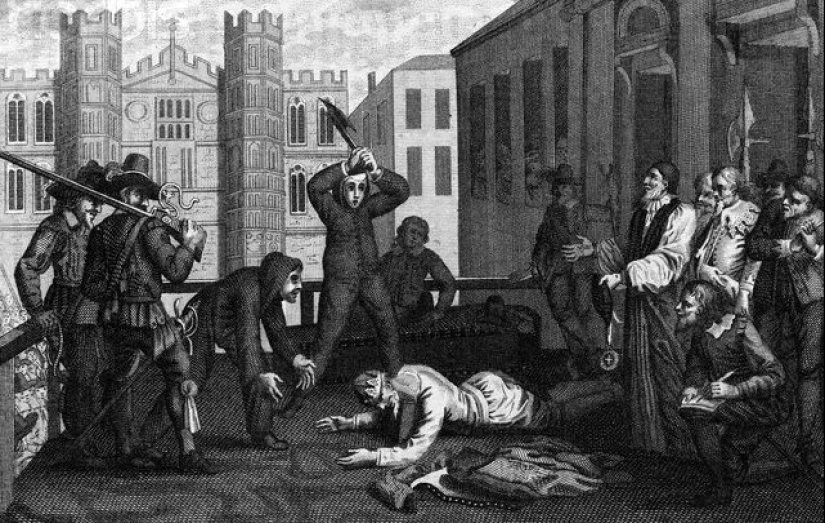Executioner's Mask — was there a sinister attribute, or is it fiction
Categories: History | Society | World
By Pictolic https://pictolic.com/article/executioners-mask-was-there-a-sinister-attribute-or-is-it-fiction.htmlThe profession of the executioner is shrouded in a halo of gloomy romance these days. But in fact it's just a job, albeit a specific one. In the Middle Ages, executioners treated workshops like blacksmiths, bakers or shoemakers. But we don't know much about how the shoulder makers worked. For a modern person, an executioner is a strong guy in a mask or a cap hiding his face. But did people of this profession actually wear accessories that hide their face?

In cinema and literature, the executioners are certainly wearing a mask. They look at the world through its slits, it is impossible to see their faces. "Game of Thrones", "Harry Potter and the Prisoner of Azkaban", "The Three Musketeers" and many other films and literary works have accustomed us to this image of the executioner.

One of the authors of this persistent stereotype was Alexander Dumas. In "The Three Musketeers", the executioner appears at the execution of My Lady in a cloak and a mask. He opened his face before the execution of justice in order to increase the horror of the condemned. It was he who once branded a woman on the shoulder.
In "Twenty Years Later", the executioners who executed King Charles I were wearing masks. In this case, their fears of being recognized are not groundless at all. The defeated monarch had many supporters who were burning with a desire for revenge. And so it turned out, as soon as the son of the beheaded king Charles II came to power, all those involved in his death paid. Although almost all the old engravings and paintings dedicated to the death of the king, he is executed by people without masks.

But frescoes, engravings and paintings from the Middle Ages say that the executioners did their job without hiding their faces. No document says that the executor of the sentence should remain incognito. Yes, it would be illogical. Judge for yourself — the executioners were usually professionals who inherited their craft. Representatives of the dynasties were well known in European policies both by face and by name.
However, there were exceptions. For example, in small towns in Italy, the executioners still hid their faces. This was due to the fact that there was no full-time executioner in the community, where only a couple of thousand residents live. Why do we need such a specialist if executions were very rare? Therefore, if there was a need to behead, hang or drown someone, the role of the executioner was performed by one of the locals.
Usually this unpleasant business was entrusted to someone from respected and even noble citizens. It is quite clear that no one is particularly eager to bear the stigma of a murderer, albeit a legitimate one. Therefore, a person who undertook an unpleasant and not honorable task hid his person from the public.

In France, executioners were considered civil servants and received a salary. They also had the right to a part of the executed person's property, at least his clothes and jewelry. Even if the executed man had desperate friends, they did not dare to take revenge. Firstly, after such a massacre, it was possible to become a "patient" of a new shoulder craftsman. And secondly, the executioner was still treated as people fulfilling someone else's will, a kind of instrument of justice. Such an application to an axe or a gallows.
Another reason why masks were not popular lies in religious and social beliefs. The Church taught that masks and disguises are from the evil one. An honest and God-fearing person does not need to hide his face and thereby frighten others. The people believed that justice should be "with a human face," and hiding is the lot of villains.

In Russia, executioners also did not wear masks. They dressed up for the execution in scarlet shirts, on which blood splashes are not so visible. The descriptions of the executions of the time of Ivan the Terrible, the beheading of Emelyan Pugachev and other judicial reprisals that have come down to us say that the executioners were well known to everyone.
However, the popularity of the executioners often played against them. People shunned these people, and their children could not go to school with the children of other citizens. Perhaps the lack of communication oppressed the executioners, but because of the education of the offspring, they were hardly upset. The executioner's son usually became an executioner, and this profession requires only knowledge of anatomy and the presence of strong nerves.
The executioners also had some privileges. In many European cities, they could take food from merchants for free. Exactly in the amount that is necessary for the sustenance of himself and his family. Of course, the sellers had to know such customers by sight, so the mask only interfered here.

Summing up, we can say that masked executioners were the exception rather than the rule. They hid their faces only during special political executions or in certain localities where such a tradition existed. So Dumas is not completely deceiving his readers.
The executioners of the 20th century were more like inconspicuous clerks at all. For example, the famous British executioner Albert Pierpoint came to the execution in a suit and tie.
Recent articles

Although today it is customary to scold sugar harshly, people have not yet learned to do without it. The history of mankind is ...

Read and find out that there is something else to do in the army besides peeling potatoes. Making a bridge at gunpoint. Breaking ...

Denis Núñez Rodríguez is a contemporary Cuban artist who works in the genres of realism and surrealism. His paintings are ...